Economy of Germany: Difference between revisions
No edit summary |
Updated GDP and GDP per capita to latest data |
||
| Line 9: | Line 9: | ||
|organs = [[European Union|EU]], [[World Trade Organization|WTO]] (via EU membership) and [[Organisation for Economic Co-operation and Development|OECD]] |
|organs = [[European Union|EU]], [[World Trade Organization|WTO]] (via EU membership) and [[Organisation for Economic Co-operation and Development|OECD]] |
||
|rank = [[List of countries by GDP (nominal)|4th]] (nominal) / [[List of countries by GDP (PPP)|5th]] (PPP) |
|rank = [[List of countries by GDP (nominal)|4th]] (nominal) / [[List of countries by GDP (PPP)|5th]] (PPP) |
||
|gdp = $3. |
|gdp = $3.747 trillion (2014 nominal)<ref>{{cite web | url=http://www.imf.org/external/pubs/ft/weo/2013/02/weodata/weorept.aspx?pr.x=38&pr.y=13&sy=2013&ey=2014&scsm=1&ssd=1&sort=country&ds=.&br=1&c=134&s=NGDPD%2CNGDPDPC%2CPPPGDP%2CPPPPC&grp=0&a= | title=Germany | publisher=[[IMF]] | accessdate=5 February 2014}}</ref> |
||
$3.325 trillion (2014 PPP) |
|||
|growth = {{increase}} 0.4% (2013)<ref>[https://www.destatis.de/EN/Homepage.html Federal Statistical Office]</ref> |
|||
|growth = {{increase}} 1.8% (2014)<ref>http://www.germany.info/Vertretung/usa/en/__pr/P__Wash/2014/04/16-GDP-Growth.html]</ref> |
|||
|per capita = $41,245 (PPP; 2012 est.)<ref>{{cite web | url=http://data.worldbank.org/indicator/NY.GDP.PCAP.PP.CD | title=GDP per capita, PPP (current international $) | publisher=[[The World Bank]] | accessdate=5 February 2014}}</ref> |
|||
|per capita = $45,925 (nominal 2014 est.)<ref>{{cite web | url=http://www.imf.org/external/pubs/ft/weo/2013/02/weodata/weorept.aspx?pr.x=38&pr.y=13&sy=2013&ey=2014&scsm=1&ssd=1&sort=country&ds=.&br=1&c=134&s=NGDPD%2CNGDPDPC%2CPPPGDP%2CPPPPC&grp=0&a= | title=Germany | publisher=[[IMF]] | accessdate=5 February 2014}}</ref> |
|||
$40,756 (PPP 2014 est.) |
|||
|sectors = agriculture: 0.8%, industry: 28%, services: 71.2% (2012 est.) |
|sectors = agriculture: 0.8%, industry: 28%, services: 71.2% (2012 est.) |
||
|inflation = 1.43% (December 2013)<ref>{{cite web | url=http://www.inflation.eu/inflation-rates/germany/inflation-germany.aspx | title=Inflation Germany – current German inflation | publisher=inflation.eu | accessdate=5 February 2014}}</ref> |
|inflation = 1.43% (December 2013)<ref>{{cite web | url=http://www.inflation.eu/inflation-rates/germany/inflation-germany.aspx | title=Inflation Germany – current German inflation | publisher=inflation.eu | accessdate=5 February 2014}}</ref> |
||
Revision as of 23:24, 16 May 2014
 Frankfurt, financial capital of Germany. | |
| Currency | Euro (EUR)[1] |
|---|---|
| calendar year | |
Trade organisations | EU, WTO (via EU membership) and OECD |
| Statistics | |
| GDP | $3.747 trillion (2014 nominal)[2] $3.325 trillion (2014 PPP) |
GDP growth | |
GDP per capita | $45,925 (nominal 2014 est.)[4] $40,756 (PPP 2014 est.) |
GDP by sector | agriculture: 0.8%, industry: 28%, services: 71.2% (2012 est.) |
| 1.43% (December 2013)[5] | |
| .27 (2006) | |
Labour force | 43.93 million (2012 est.) |
Labour force by occupation | agriculture (2,4%), industry (29,7%), services (67,8%) (2005) |
| Unemployment | 6.7% (March 2014)[6] |
Average gross salary | €2,977 / $4,076, monthly (2013) |
| €1,889 / $2,600, monthly (2013) | |
Main industries | iron and steel, coal, cement, mineral fuels, chemicals, plastics, production machinery, vehicles, trains, machine tools, electronics, food and beverages, shipbuilding, space and aircraft, optical and medical apparatus, pharmaceuticals, textiles, agriculture |
| External | |
| Exports | $1.492 trillion (2012 est.)[7] |
Export goods | motor vehicles, machinery, chemicals, computer and electronic products, electrical equipment, pharmaceuticals, metals, transport equipment, foodstuffs, textiles, rubber and plastic products |
Main export partners | |
| Imports | $1.276 trillion (2012 est.)[7] |
Import goods | machinery, data processing equipment, vehicles, chemicals, oil and gas, metals, electric equipment, pharmaceuticals, foodstuffs, agricultural products |
Main import partners | |
FDI stock | $1.057 trillion (31 December 2010 est.) |
Gross external debt | $5.624 trillion (30 June 2011) |
| Public finances | |
| 81.0% of GDP (2013)[10] | |
| Revenues | $1.511 trillion (2012 est.) |
| Expenses | $1.507 trillion (2012 est.) |
| Economic aid | donor: $7.5 billion (€5 billion), 0.28% of GDP Germany is ranked on the CPI [11] 2013 as 12th for the perceived level corruption |
| Standard & Poor's: AAA[12] Outlook: Stable[13] Moody's: Aaa[13] Outlook: Stable Fitch: AAA[13] Outlook: Stable | |
| $233.813 billion, €200 billion (April 2011)[14] | |
All values, unless otherwise stated, are in US dollars. | |
Germany is the largest national economy in Europe, the fourth-largest by nominal GDP in the world, and fifth by GDP (PPP). Since the age of industrialisation and beyond, the country has been a driver, innovator, and beneficiary of an ever more globalised economy. Germany's economic policy is based on the concept of the social market economy. The country is a founding member of the European Union and the Eurozone.[15][16] Germany is the third largest exporter in the world with $1.516 trillion exported in 2012.[17][needs update] Exports account for more than one-third of national output.[18][needs update] [19] In 2013, Germany recorded the highest trade surplus in the world worth $270 billion,[20] making it the biggest capital exporter globally.[21] Among the top 10 biggest economies in the world, Germany is the only country with a stable Triple-A (AAA) credit rating.
Germany is the largest producer of lignite in the world. Germany is also rich in timber, iron ore, potash, salt, uranium, nickel, copper and natural gas. Energy in Germany is sourced predominantly by fossil fuels, followed by nuclear power, and by renewable energy like biomass (wood and biofuels), wind, hydro and solar.
The service sector contributes around 70% of the total GDP, industry 29.1%, and agriculture 0.9%. Most of the country's products are in engineering, especially in automobiles, machinery, metals, and chemical goods.[22] Germany is the leading producer of wind turbines and solar power technology in the world.[23] Combination of service-oriented manufacturing,[24] R&D spending, links between industry and academia, international cooperation and the Mittelstand contribute to the overall competitiveness of the economy of Germany.[25][26]
Germany is the world's top location for trade fairs. Around two thirds of the world's leading trade fairs take place in Germany.[27] The largest annual international trade fairs and congresses are held in several German cities such as Hanover, Munich, Frankfurt and Berlin.
Of the world's 500 largest stock market listed companies measured by revenue, the Fortune Global 500, 37 are headquartered in Germany. In 2012 the ten largest were Volkswagen, Allianz, E.ON, Daimler, Siemens, Metro, Deutsche Telekom, Munich Re, BASF, and BMW.[28] Other large German companies include: Robert Bosch, ThyssenKrupp, Continental AG, MAN and Trumpf (diversified industrials); KUKA (robotics); Bayer and Merck (pharmaceuticals); Adidas and Puma (clothing and footwear); Commerzbank and Deutsche Bank (banking and finance); Deutsche Bahn (rail transport); Aldi, Lidl, and Edeka (retail); SAP (computer software); Infineon (semiconductors); Henkel and Miele (household and personal consumer products); Deutsche Post (logistics); Bertelsmann (mass media); and Hugo Boss (luxury goods). Well-known global brands are Mercedes Benz, BMW, Adidas, Audi, Porsche, Volkswagen, Bayer, BASF, Bosch, Siemens, Lufthansa, SAP and Nivea.[29]
History
Since the age of industrialisation, the country has been a driver, innovator, and beneficiary of an ever more globalized economy. Germany is a founding member of the EU, the G8 and the G20 and was the world's largest exporter from 2003 to 2008. In 2011, it remains the second largest exporter[17] and third largest importer.[30] It generates a trade surplus of $270 billion,[20] making it the biggest capital exporter globally.
Germany is the only country among the top five arms exporters that is not a permanent member of the United Nations Security Council.[31]

Before 1850 Germany lagged behind the leaders in industrial development, Britain, France and Belgium. By 1850 the German states were catching up, and by 1900 Germany was a world leader in industrialization, along with Britain and the United States. In 1800, Germany's social structure was poorly suited to entrepreneurship or economic development.
The reaction to Napoleon's conquests of German countries during the era of the French Revolution (1790s to 1815), produced important institutional reforms, including the abolition of feudal restrictions on the sale of large landed estates, the reduction of the power of the guilds in the cities, and the introduction of a new, more efficient commercial law. Nevertheless, traditionalism remained strong in most of Germany.
Until midcentury, the guilds, the landed aristocracy, the churches, and the government bureaucracies had so many rules and restrictions that entrepreneurship was held in low esteem, and given little opportunity to develop. From the 1830s and 1840s, Prussia, Saxony, and other states reorganized agriculture, introducing sugar beets, turnips, and potatoes, yielding a higher level of food production that enabled a surplus rural population to move to industrial areas.
The beginnings of the industrial revolution in Germany came in the textile industry, and was facilitated by eliminating tariff barriers through the Zollverein (customs union), starting in 1834. The takeoff stage of economic development came with the railroad revolution in the 1840s, which opened up new markets for local products, created a pool of middle managers, increased the demand for engineers, architects and skilled machinists and stimulated investments in coal and iron.[32] The political decisions about the economy of Prussia (and after 1871 all Germany) were largely controlled by a coalition of "rye and iron", that is the Junker landowners of the east and the heavy industry of the west.[33]
Third Reich
The economy of Germany during the Hitler era (1933 – 1945) developed a hothouse prosperity, supported with high government subsidies to those sectors that Hitler favored because they gave Nazi Germany military power and economic autarky, that is, economic independence from the global economy.
Adolf Hitler, believing that "the economy is something of secondary importance",[34] left the details of the economic National Socialist Programme out of Mein Kampf.[35] The Nazis rose to power while unemployment was very high,[36] but achieved full employment later thanks to massive rearmament.[37] Their pre-war economic policies were in the beginning the brainchildren of their non-Nazi Minister of Economics, Hjalmar Schacht,[36] who was later made to focus more on war production, and was eventually replaced by a Nazi, Hermann Göring.
The trading policies of the Third Reich aimed at discouraging trade with countries outside the German sphere of influence,[38] while making southern Europe largely dependent on Germany.[39] Eventually, the Nazi party developed strong relationships with big business[40] and abolished trade unions[41] while real wages dropped by a fourth,[37] and employees could not easily change employer.[41] Taxes, though, were still low well into the war.[42]
Already before the war, people undesirable to the regime were used as slave labour, and in 1944 they accounted for one quarter of the workers.[43] Some historians, like the British Marxist Timothy Mason, have argued that the Second World War was a direct effect of the German economic system, which made expansionism necessary for domestic prosperity, indeed, survival; and which made Jingoism necessary for the quelling of class conflicts.[44] Mason called the outbreak of World War II in 1939 a "flight into war" imposed on Hitler by an economic crisis.[45]
West Germany
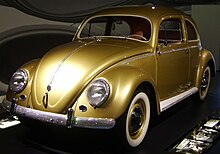
Beginning with the replacement of the Reichsmark with the Deutsche Mark as legal tender, a lasting period of low inflation and rapid industrial growth was overseen by the government led by German Chancellor Konrad Adenauer and his minister of economics, Ludwig Erhard, raising West Germany from total wartime devastation to one of the most developed nations in modern Europe.
Contrary to popular belief, the Marshall Plan, which was extended to also include Western Germany after it was realized that the suppression of the Western German economy was holding back the recovery of the rest of Europe,[46] was not the main force behind the Wirtschaftswunder.[47][48] The amount of monetary aid (which was in the form of loans) received by Germany through the Marshall Plan (about $1.65 billion in total) was far overshadowed by the amount the Germans had to pay back as war reparations and by the charges the Allies made on the Germans for the ongoing cost of occupation (about $2.4 billion per year).[47]
In 1953 it was decided that Germany was to repay $1.1 billion of the aid it had received. The last repayment was made in June 1971.[48] It is arguable, however, that recovery would have been possible without the initial economic boost as well as the modernization of infrastructure provided by the economic recovery plan.
Apart from these factors, hard work and long hours at full capacity among the population in the 1950s, 1960s and early 1970s and extra labor supplied by thousands of Gastarbeiter ("guest workers") provided a vital base for the economic upturn.
East Germany
By the early 1950s the Soviet Union had seized reparations in the form of agricultural and industrial products and demanded further heavy reparation payments.[49] Lower Silesia, which contained coal mines, and Stettin, a prominent natural port, were lost to Poland.
Exports from West Germany exceeded $323 billion in 1988. In the same year, East Germany exported $30.7 billion worth of goods; 65% to other communist states.[50] East Germany had zero unemployment.[50]
In 1976 the average annual GDP growth was roughly 5.9%.[51]
Berlin Republic
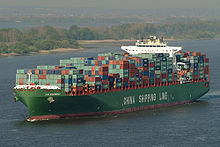
The German economy practically stagnated in the beginning of the 2000s. The worst growth figures were achieved in 2002 (+1.4%), in 2003 (+1.0%) and in 2005 (+1.4%).[52] Unemployment was also chronically high.[53] Due to these problems, together with Germany's aging population, the welfare system came under considerable strain. This led the government to push through a wide-ranging programme of belt-tightening reforms, Agenda 2010, including the labour market reforms known as Hartz I - IV.[53]
In the later part of the first decade of 2000 the world economy experienced high growth, from which Germany as a leading exporter also profited. Some credit the Hartz reforms with achieving high growth and declining unemployment but others contend that they resulted in a massive decrease in standards of living, and that its effects are limited and temporary.[53]
The nominal GDP of Germany contracted in the second and third quarters of 2008, putting the country in a technical recession following a global and European recession cycle.[54] German industrial output dropped to 3.6% in September vis-a-vis August.[55][56] In January 2009 the German government under Angela Merkel approved a €50 billion ($70 billion) economic stimulus plan to protect several sectors from a downturn and a subsequent rise in unemployment rates.[57] Germany exited the recession in the second and third quarters of 2009, mostly due to rebounding manufacturing orders and exports - primarily from outside the Euro Zone - and relatively steady consumer demand.[53]
Germany is a founding member of the EU, the G8 and the G20, and was the world's largest exporter from 2003 to 2008. In 2011 it remained the third largest exporter[17] and third largest importer.[30] Most of the country's exports are in engineering, especially machinery, automobiles, chemical goods and metals.[22] Germany is a leading producer of wind turbines and solar-power technology.[58] Annual trade fairs and congresses are held in cities throughout Germany.[59] 2011 was a record-breaking year for the German economy. German companies exported goods worth over €1 trillion ($1.3 trillion), the highest figure in history. The number of people in work has risen to 41.6 million, the highest recorded figure.[60]
Through 2012, Germany's economy continued to be stronger relative to local neighboring nations.[61]
Data
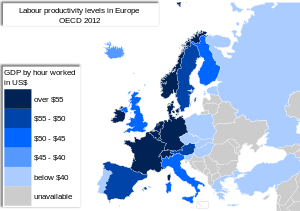


As of December 2012[update], the unemployment rate was 6.7 percent.[63]
As of December 2012[update], the CPI rate was 2.10 percent.
The following table lists the non-seasonally adjusted GDP growth in 1992-2012.[64]
| Year | GDP €Billion |
Change |
|---|---|---|
| 1992 | 1648.40 | +1.9% |
| 1993 | 1696.90 | -1.0% |
| 1994 | 1782.20 | +2.5% |
| 1995 | 1848.50 | +1.7% |
| 1996 | 1875.00 | +0.8% |
| 1997 | 1912.60 | +1.7% |
| 1998 | 1959.70 | +1.9% |
| 1999 | 2000.20 | +1.9% |
| 2000 | 2047.50 | +3.1% |
| 2001 | 2101.90 | +1.5% |
| 2002 | 2132.20 | +0.0% |
| 2003 | 2147.50 | -0.4% |
| 2004 | 2195.70 | +1.2% |
| 2005 | 2224.40 | +0.7% |
| 2006 | 2313.90 | +3.7% |
| 2007 | 2428.50 | +3.3% |
| 2008 | 2473.80 | +1.1% |
| 2009 | 2374.50 | -5.1% |
| 2010 | 2496.20 | +4.2% |
| 2011 | 2592.60 | +3.0% |
| 2012 | 2645.00 | +0,7% |
Companies
Of the world's 500 largest stock-market-listed companies measured by revenue in 2010, the Fortune Global 500, 37 are headquartered in Germany. 30 Germany-based companies are included in the DAX, the German stock market index. Well-known global brands are Mercedes-Benz, BMW, SAP, Siemens, Volkswagen, Adidas, Audi, Allianz, Porsche, Bayer, BASF, Bosch, and Nivea.[65]
Germany is recognised for its specialised small and medium enterprises. Around 1,000 of these companies are global market leaders in their segment and are labelled hidden champions.[66]
From 1991 to 2010, 40,301 mergers and acquisitions with an involvement of German firms with a total known value of 2,422 bil. EUR have been announced.[67] The largest transactions[68] since 1991 are: the acquisition of Mannesmann by Vodafone for 204.8 bil. EUR in 1999, the merger of Daimler-Benz with Chrysler to form DaimlerChrysler in 1998 valued at 36.3 bil. EUR.

The list includes the largest German companies by revenue in 2011:
| Rank[69] | Name | Headquarters | Revenue (Mil. €) |
Profit (Mil. €) |
Employees (World) |
|---|---|---|---|---|---|
| 1. | Volkswagen AG | Wolfsburg | 159,000 | 15,800 | 502,000 |
| 2. | E.ON SE | Düsseldorf | 113,000 | −1,900 | 79,000 |
| 3. | Daimler AG | Stuttgart | 107,000 | 6,000 | 271,000 |
| 4. | Siemens AG | Berlin, München | 74,000 | 6,300 | 360,000 |
| 5. | BASF SE | Ludwigshafen am Rhein | 73,000 | 6,600 | 111,000 |
| 6. | BMW AG | München | 69,000 | 4,900 | 100,000 |
| 7. | Metro AG | Düsseldorf | 67,000 | 740 | 288,000 |
| 8. | Schwarz-Gruppe (Lidl) | Neckarsulm | 63,000 | N/A | 315,000 |
| 9. | Deutsche Telekom AG | Bonn | 59,000 | 670 | 235,000 |
| 10. | Deutsche Post AG | Bonn | 53,000 | 1,300 | 471,000 |
| — | Allianz SE | München | 104,000 | 2,800 | 141,000 |
| — | Deutsche Bank AG | Frankfurt am Main | 2,160,000 | 4,300 | 101,000 |
Economic region
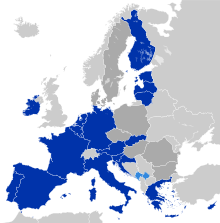
Germany as a federation is a polycentric country and does not have a single economic center. The stock exchange is located in Frankfurt am Main, the largest Media company (Bertelsmann AG) is headquartered in Gütersloh; the largest car manufacturers are in Wolfsburg, Stuttgart and München.[70]
Germany is an advocate of closer European economic and political integration. Its commercial policies are increasingly determined by agreements among European Union (EU) members and EU single market legislation. Germany introduced the common European currency, the euro on 1 January 1999. Its monetary policy is set by the European Central Bank in Frankfurt.
The southern states ("Bundesländer"), especially Bayern, Baden-Württemberg and Hessen, are economically stronger than the northern states. One of Germany's traditionally strongest (and at the same time oldest) economic regions is the Ruhr area in the west, between Bonn and Dortmund. 27 of the country's 100 largest companies are located there. In recent years, however, the area, whose economy is based on natural resources and heavy industry, has seen a substantial rise in unemployment (2010: 8.7%).[70]
The economy of Bayern and Baden-Württemberg, the states with the lowest number of unemployed people (2010: 4.5%, 4.9%), on the other hand, is based on high-value products. Important sectors are automobiles, electronics, aerospace and biomedicine, among others. Baden-Württemberg is an industrial center especially for automobile and machine building industry and the home of brands like Mercedes-Benz (Daimler), Porsche and Bosch.[70]
With the reunification on 3 October 1990, Germany began the major task of reconciling the economic systems of the two former republics. Interventionist economic planning ensured a gradual increase up to the level of former western Germany. But the standard of living and annual income remains significantly higher in western German states.[71] The modernisation and integration of the eastern German economy continues to be a long-term process scheduled to last until the year 2019, with annual transfers from west to east amounting to roughly $80 billion. The overall unemployment rate has consistently fallen since 2005 and reached a 20-year low in 2012.
Wealth

The following top 10 list of German billionaires is based on an annual assessment of wealth and assets compiled and published by Forbes magazine on March 4, 2014.[72]
- $25 billion Karl Albrecht
- $21.1 billion Dieter Schwarz
- $19.3 billion Theo Albrecht
- $18.4 billion Michael Otto & family
- $17.4 billion Susanne Klatten
- $14.9 billion Stefan Quandt
- $14.3 billion Georg Schaeffler
- $12.8 billion Johanna Quandt
- $10.4 billion Klaus-Michael Kühne
- $8.8 billion Hasso Plattner
Wolfsburg is the richest city in Germany with per capita income of $128,000. The following top 10 list of German cities with the highest income per person is based on a study by the Cologne Institute for Economic Research on July 31, 2013.[73]
- $128,000 Wolfsburg, Lower Saxony
- $114,281 Frankfurt am Main, Hesse
- $108,347 Schweinfurt, Bavaria
- $104,000 Ingolstadt, Bavaria
- $99,389 Regensburg, Bavaria
- $92,525 Düsseldorf, North-Rhine Westphalia
- $92,464 Ludwigshafen am Rhein, Rhineland-Palatinate
- $91,630 Erlangen, Bavaria
- $91,121 Stuttgart, Baden-Württemberg
- $88,692 Ulm, Baden-Württemberg
Natural resources

The German soil is relatively poor in raw materials. Only lignite (brown coal) and potash salt (Kalisalz) are available in significant quantities. However, the former GDR's Wismut mining company produced a total of 230,400 tonnes of uranium between 1947 and 1990 and made East Germany the fourth largest producer of uranium ore worldwide (largest in USSR's sphere of control) at the time. Oil, natural gas and other resources are, for the most part, imported from other countries.[74]
Potash salt is mined in the center of the country (Niedersachsen, Sachsen-Anhalt and Thüringen). The most important producer is K+S AG (formerly Kali und Salz AG).[74]
Germany's bituminous coal deposits were created more than 300 million years ago from swamps which extended from the present-day South England, over the Ruhr area to Poland. Lignite deposits developed in a similar way, but during a later period, about 66 million years ago. Because the wood is not yet completely transformed into coal, brown coal contains less energy than bituminous coal.[74]
Lignite is extracted in the extreme western and eastern parts of the country, mainly in Nordrhein-Westfalen, Sachsen and Brandenburg. Considerable amounts are burned in coal plants near to the mining areas, to produce electricity. Transporting lignite over far distances is not economically feasible, therefore the plants are located practically next to the extraction sites. Bituminous coal is mined in Nordrhein-Westfalen and Saarland. Most power plants burning bituminous coal operate on imported material, therefore the plants are located not only near to the mining sites, but throughout the country.[74]
Sectors

Germany has a social market economy characterised by a highly qualified labour force, a developed infrastructure, a large capital stock, a low level of corruption,[75] and a high level of innovation.[76] It has the largest national economy in Europe, the fourth largest by nominal GDP in the world, and ranked fifth by GDP (PPP) in 2009.
The service sector contributes around 70% of the total GDP, industry 29.1%, and agriculture 0.9%.[77]
Primary
In 2010 agriculture, forestry, and mining accounted for only 0.9% of Germany’s gross domestic product (GDP) and employed only 2.4% of the population,[22] down from 4% in 1991. Agriculture is extremely productive, and Germany is able to cover 90% of its nutritional needs with domestic production. Germany is the third largest agricultural producer in the European Union after France and Italy. Germany’s principal agricultural products are potatoes, wheat, barley, sugar beets, fruit, and cabbages.
Despite the country’s high level of industrialization, almost one-third of its territory is covered by forest.[78] The forestry industry provides for about two-thirds of domestic consumption of wood and wood products, so Germany is a net importer of these items.
Industry
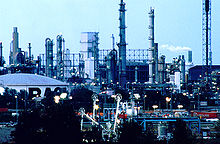
Industry and construction accounted for 29% of gross domestic product in 2008, and employed 29.7% of the workforce.[22] Germany excels in the production of automobiles, machinery, electrical equipment and chemicals. With the manufacture of 5.2 million vehicles in 2009, Germany was the world’s fourth largest producer and largest exporter of automobiles. German automotive companies enjoy an extremely strong position in the so-called premium segment, with a combined world market share of about 90%.
Small- to medium-sized manufacturing firms (Mittelstand companies) which specialize in technologically advanced niche products and are often family-owned and form major part of the German economy.[79] It is estimated that about 1500 German companies occupy a top three position in their respective market segment worldwide. In about two thirds of all industry sectors German companies belong to the top three competitors.[80]
Services
In 2008 services constituted 69% of gross domestic product (GDP), and the sector employed 67.5% of the workforce.[22] The subcomponents of services are financial, renting, and business activities (30.5%); trade, hotels and restaurants, and transport (18%); and other service activities (21.7%).
The largest annual international trade fairs and congresses are held in several German cities such as Hanover, Frankfurt, and Berlin.[81]
Germany is the third most visited country in Europe, with a total of 369.6 million overnights during 2010.[82][83]
Infrastructure
Energy
Germany is the world's fifth largest consumer of energy, and two-thirds of its primary energy was imported in 2002. In the same year, Germany was Europe's largest consumer of electricity, totaling 512.9 terawatt-hours. Government policy promotes energy conservation and the development of renewable energy sources, such as solar, wind, biomass, hydroelectric, and geothermal energy. As a result of energy-saving measures, energy efficiency has been improving since the beginning of the 1970s. The government has set the goal of meeting half the country's energy demands from renewable sources by 2050.
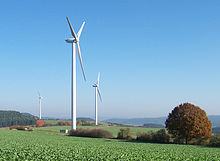
In 2000, the red-green coalition under Chancellor Schröder and the German nuclear power industry agreed to phase out all nuclear power plants by 2021.[84] The conservative coalition under Chancellor Merkel reversed this decision in January 2010, electing to keep plants open. The nuclear disaster of the Japanese nuclear plant Fukushima in March 2011 however, changed the political climate fundamentally: Older nuclear plants have been shut down. And a general phase out until 2020 or 2022 is now probable. Renewable energy yet still plays a more modest role in energy consumption, though German solar and windpower industries play a leading role worldwide.
In 2009, Germany consumed energy from the following sources:[85] Oil 34.6%, Natural gas 21.7%, Lignite 11.4%, Bituminous coal 11.1%, Nuclear power 11.0%, Hydro and wind power 1.5%, Others 9.0%.
There are 3 major entry points for oil pipelines: in the northeast (the Druzhba pipeline, coming from Gdańsk), west (coming from Rotterdam) and southeast (coming from Nelahozeves). The oil pipelines of Germany do not constitute a proper network, and sometimes only connect two different locations. Major oil refineries are located in or near the following cities: Schwedt, Spergau, Vohburg, Burghausen, Karlsruhe, Cologne, Gelsenkirchen, Lingen, Wilhelmshaven, Hamburg and Heide.[86]
Germany's network of natural gas pipelines, on the other hand, is dense and well-connected. Imported pipeline gas comes mostly from Russia, the Netherlands and the United Kingdom. Although gas imports from Russia have been historically reliable, even during the cold war, recent price disputes between Gazprom and the former Soviet states, such as Ukraine, have also affected Germany. As a result, high political importance is placed on the construction of the Nord Stream pipeline, running from Vyborg in Russia along the Baltic sea to Greifswald in Germany. This direct connection avoids third-party transit countries.[86]
Transport

With its central position in Europe, Germany is an important transportation hub. This is reflected in its dense and modern transportation networks. The extensive motorway (Autobahn) network that ranks worldwide third largest in its total length and features a lack of blanket speed limits on the majority of routes.[87]
Germany has established a polycentric network of high-speed trains. The InterCityExpress or ICE is the most advanced service category of the Deutsche Bahn and serves major German cities as well as destinations in neighbouring countries. The train maximum speed varies between 200 km/h and 320 km/h (125-200 mph). Connections are offered at either 30-minute, hourly, or two-hourly intervals.[88]
The largest German airports are the Frankfurt International Airport and the Munich International Airport, both are global hubs of Lufthansa. Other major airports are Berlin Tegel, Berlin Schönefeld, Düsseldorf, Hamburg, Hanover, Cologne-Bonn, Leipzig/Halle and in the future Berlin Brandenburg International Airport.
Technology
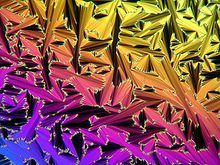
Germany's achievements in sciences have been significant, and research and development efforts form an integral part of the economy.[90]
Germany is also one of the leading countries in developing and using green technologies. Companies specializing in green technology have an estimated turnover of €200 billion. Especially the expertise in engineering, science and research of Germany is eminently respectable.
The lead markets of Germany's green technology industry are power generation, sustainable mobility, material efficiency, energy efficiency, waste management and recycling, sustainable water management.[91]
With regard to triadic patents Germany is in third place after the USA and Japan. With more than 26,500 registrations for patents submitted to the European Patent Office, Germany is the leading European nation. Siemens, Bosch and BASF, with almost 5,000 registrations for patents between them in 2008, are among the Top 5 of more than 35,000 companies registering patents. Together with the USA and Japan, with regard to patents for nano, bio and new technologies Germany is one of the world’s most active nations. With around one third of triadic patents Germany leads the way worldwide in the field of vehicle emission reduction.[92]
See also
- Deutsche Bundesbank
- German model
- List of German states by GDP
- Metropolitan regions in Germany
- Taxation in Germany
- Trade unions in Germany
References
- ^ Before 2002: Deutsche Mark (DEM).
- ^ "Germany". IMF. Retrieved 5 February 2014.
- ^ http://www.germany.info/Vertretung/usa/en/__pr/P__Wash/2014/04/16-GDP-Growth.html]
- ^ "Germany". IMF. Retrieved 5 February 2014.
- ^ "Inflation Germany – current German inflation". inflation.eu. Retrieved 5 February 2014.
- ^ German unemployment falls for a fourth straight month
- ^ a b http://www.destatis.de/jetspeed/portal/cms/Sites/destatis/Internet/EN/Content/Statistics/VolkswirtschaftlicheGesamtrechnungen/Inlandsprodukt/Tabellen/Content75/Gesamtwirtschaft,templateId=renderPrint.psml
- ^ "Export Partners of Germany". CIA World Factbook. 2012. Retrieved 23 July 2013.
- ^ "Import Partners of Germany". CIA World Factbook. 2012. Retrieved 23 July 2013.
- ^ Federal Statistical Office
- ^ http://www.transparency.org/policy_research/surveys_indices/cpi/2009/cpi_2009_table
- ^ "Sovereigns rating list". Standard & Poor's. Retrieved 26 May 2011.
- ^ a b c Rogers, Simon; Sedghi, Ami (15 April 2011). "How Fitch, Moody's and S&P rate each country's credit rating". The Guardian. Retrieved 31 May 2011.
- ^ "International Reserves and Foreign Currency Liquidity - GERMANY". International Monetary Fund. 16 May 2011. Retrieved 31 May 2011.
- ^ http://books.google.com.tw/books?id=ENWMZqhD9RYC&pg=PA593&hl=zh-TW&source=gbs_toc_r&cad=3#v=onepage&q&f=false
- ^ http://www.hup.harvard.edu/catalog.php?isbn=9780674789951
- ^ a b c "Country Comparison :: Exports". The World Factbook. Central Intelligence Agency. ISSN 1553-8133. Retrieved 9 August 2012.
- ^ Library of Congress – Federal Research Division (April 2008). "Country Profile: Germany" (PDF). p. 10. Retrieved 11 January 2009.
Exports are responsible for one-third of total economic output, and at the prevailing dollar–euro exchange rate, no country exports more merchandise.
- ^ http://www.voxeu.org/article/germany-s-capital-exports-under-euro
- ^ a b http://www.nst.com.my/world/german-trade-surplus-soars-to-all-time-high-in-2013-1.479090
- ^ http://www.koenig-cie.de/de/node/9091
- ^ a b c d e CIA. "CIA Factbook". Retrieved 2 August 2009.
- ^ Wind Power Federal Ministry of Economics and Technology (Germany) Retrieved 30 November 2006.
- ^ http://mpra.ub.uni-muenchen.de/38995/2/MPRA_paper_38995.pdf
- ^ http://liu.diva-portal.org/smash/get/diva2:20750/FULLTEXT01
- ^ http://www.foresight-platform.eu/wp-content/uploads/2011/02/EFMN-Brief-No.-137_-Manufacturing-in-Europe.pdf
- ^ "Trade fairs in Germany". German National Tourist Board. Retrieved 5 February 2014.
- ^ http://topforeignstocks.com/2013/03/19/the-32-largest-german-companies-by-revenue-2012/
- ^ Archived 2008-01-06 at the Wayback Machine, Businessweek. Retrieved 26 November 2007.
- ^ a b "Country Comparison :: Imports". The World Factbook. Central Intelligence Agency. ISSN 1553-8133. Retrieved 9 August 2012.
- ^ "China Replaces U.K. in Top-Five Arms Exporters Headed by U.S."
- ^ Richard Tilly, "Germany: 1815-1870" in Rondo Cameron, ed. Banking in the Early Stages of Industrialization: A Study in Comparative Economic History (Oxford University Press, 1967), pages 151-182
- ^ Cornelius Torp, "The "Coalition of 'Rye and Iron'" under the Pressure of Globalization: A Reinterpretation of Germany's Political Economy before 1914," Central European History Sept 2010, Vol. 43 Issue 3, pp 401-427
- ^ Henry A. Turner, "Hitler's Einstellung", 1976, p. 90–91
- ^ Henry A. Turner, "German Big Business and the Rise of Hitler", Oxford University Press, 1985. p.77
- ^ a b "http://econ161.berkeley.edu/TCEH/Slouch_Purge15.html". Retrieved 15 August 2007.
{{cite web}}: External link in|title= - ^ a b "econ161.berkeley.edu". Retrieved 15 August 2007.
- ^ Hans-Joachim Braun, "The German Economy in the Twentieth Century", Routledge, 1990, p. 101
- ^ Hans-Joachim Braun, "The German Economy in the Twentieth Century", Routledge, 1990, p. 102
- ^ Arthur Schweitzer, "Big Business in the Third Reich", Bloomington, Indiana University Press, 1964, p. 288
- ^ a b Nazis and Soviets
- ^ Hans-Joachim Braun, "The German Economy in the Twentieth Century", Routledge, 1990, p. 114
- ^ Michael Thad Allen, "The Business of Genocide", The University of North Carolina Press, 2002. p. 1
- ^ Kaillis, Aristotle Fascist Ideology, London: Routledge, 2000 pages 6-7
- ^ Perry, Matt "Mason, Timothy" pages 780-781 from The Encyclopedia of Historians and Historical Writing edited by Kelly Boyd, Volume 2, London: Fitzroy Dearborn Publishing, 1999 page 780
- ^ "Pas de Pagaille!", 28 July 1947
- ^ a b German Economic "Miracle" by David R. Henderson
- ^ a b Archived 2006-07-09 at the Wayback Machine
- ^ Norman M. Naimark. The Russians in Germany: A History of the Soviet Zone of Occupation, 1945-1949. Harvard University Press, 1995. ISBN 0-674-78405-7 pp. 167-9
- ^ a b Boyes, Roger (24 August 2007). "Germany starts recovery from €2,000bn union". London: Times Online. Retrieved 12 October 2009.
- ^ "Business America. (27 February 1989). German Democratic Republic: long history of sustained economic growth continues; 1989 may be an advantageous year to consider this market - Business Outlook Abroad: Current Reports from the Foreign Service". Business America. 1989. Retrieved 2 October 2007.
- ^ Bruttoinlandsprodukt (Vierteljahres- und Jahresangaben) Statistisches Bundesamt.
- ^ a b c d CIA Factbook: Germany
- ^ Hopkins, Kathryn (14 November 2008). "Germany officially in recession as OECD expects US to lead recovery". London: The Guardian. Retrieved 1 May 2010.
- ^ bloomberg.com, German Economy Enters Worst Recession in 12 Years
- ^ ap.google.com, German economy falls into recession[dead link]
- ^ "Germany agrees on 50-billion-euro stimulus plan". France 24. 6 January 2009.
- ^ "Wind Power". Federal Ministry of Economics and Technology. Archived from the original on 10 December 2006. Retrieved 27 March 2011.
- ^ UFI, the Global Association of the Exhibition Industry (2008). "Euro Fair Statistics 2008" (PDF). AUMA Ausstellungs- und Messe-Ausschuss der Deutschen Wirtschaft e.V. p. 12. Retrieved 24 September 2011.
- ^ "Defying the Euro Crisis". Spiegel Online. 27 December 2011.
- ^ Brain Drain Feared as German Jobs Lure Southern Europeans 28 April 2012
- ^ "Gross domestic product" (PDF) (in German). OECD. 17 February 2011. p. 4. Retrieved 11 February 2011.
- ^ Bundesagentur für Arbeit Nürnberg. "Monatsbericht 201212" (PDF) (in German). p. 78. Retrieved 19 January 2012.
- ^ "Wichtige Zusammenhänge im Überblick 2012" (PDF). Destatis. 15 January 2012. Retrieved 19 January 2012.
- ^ "The 100 Top Brands 2010". Interbrand. Retrieved 27 March 2011.
- ^ Gavin, Mike (23 September 2010). "Germany Has 1,000 Market-Leading Companies, Manager-Magazin Says". Businessweek. New York. Retrieved 27 March 2011.
- ^ http://www.imaa-institute.org/statistics-mergers-acquisitions.html#MergersAcquisitions_Germany
- ^ http://www.imaa-institute.org/statistics-mergers-acquisitions.html#TopMergersAcquisitions_Germany
- ^ "Global 500: Countries – Germany". Forbes. 26 July 2010. Retrieved 27 March 2011.
- ^ a b c Gürtler, Detlef: Wirtschaftsatlas Deutschland. Rowohlt Berlin, 2010
- ^ Berg, S., Winter, S., Wassermann, A. The Price of a Failed Reunification Spiegel Online International. 5 September 2005. Retrieved 28 November 2006.
- ^ "Special Report: German's Richest (1-10)". Retrieved 4 March 2014.
- ^ "These Are Germany's Power Cities". Retrieved 2014-3-1.
{{cite web}}: Check date values in:|accessdate=(help) - ^ a b c d Gürtler, Detlef: Wirtschaftsatlas Deutschland. Rowohlt Berlin, 2010.
- ^ "CPI 2009 table". Transparency International. Retrieved 18 November 2009.
- ^ "The Innovation Imperative in Manufacturing: How the United States Can Restore Its Edge" (PDF). Retrieved 26 September 2010.
- ^ "German Economy Experiences Record Growth in 2010" German Embassy Press Release 12 January 2011
- ^ 31.7% —or about 11,076,000 hectares— of Germany is forested, mongabay.com, 2005.
- ^ Venohr, Bernd and Meyer, Klaus E. (2007). "The German Miracle Keeps Running: How Germany's Hidden Champions Stay Ahead in the Global Economy" (PDF). Working Paper 30. FHW Berlin. Retrieved 9 October 2009.
{{cite web}}: CS1 maint: multiple names: authors list (link) - ^ Venohr, Bernd (2010). "The power of uncommon common sense management principles - The secret recipe of German Mittelstand companies - Lessons for large and small companies" (PDF). Retrieved 8 December 2010.
- ^ Archived 2006-12-10 at the Wayback Machine Federal Ministry of Economics and Technology (Germany) Retrieved 30 November 2006.
- ^ Tourismus- und Hotelatlas 2009, pages 16f
- ^ Deutscher Tourismusverband, statistical data for 2008
- ^ Germany split over green energy, BBC. Retrieved 13 April 2007
- ^ Energy Consumption in Germany
- ^ a b Detlef, Günter: Wirtschaftsatlas Deutschland. Rowohlt Berlin, 2010. p.42
- ^ "Autobahn-Temporegelung" (PDF) (in German). ADAC. October 2007. Retrieved 15 November 2008. [dead link]
- ^ Archived 2007-08-09 at the Wayback Machine, Deutsche Bahn. Retrieved 19 October 2007.
- ^ Research in Germany German Embassy, New Delhi. Retrieved 2010-28-08.
- ^ "Germany's Technological Performance". Federal Ministry of Education and Research. 11 January 2007. Retrieved 21 August 2011.
- ^ Roland Berger Strategy Consultants: Green Growth, Green Profit – How Green Transformation Boosts Business Palgrave Macmillan, New York 2010, ISBN 978-0-230-28543-9
- ^ Industry strongly engaged in research Facts about Germany. Retrieved 2010-29-08.
External links
- OECD's Germany country Web site and OECD Economic Survey of Germany
- Federal Statistical Office Germany
- World Bank Trade Summary Statistics Germany 2012
- Looking for Skilled Labor in Eastern Germany - slideshow by Der Spiegel
- Error in Webarchive template: Empty url. Germany’s growth performance in the 1990s - Published by the European Commission
- Comprehensive current and historical economic data
